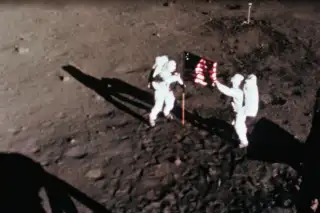The Apollo Moon Landing Cost the Equivalent of $600 Billion. Here's Why That Was a Bargain

The 1969 moon landing was no small undertaking — both in terms of achievement and budget. The 50th anniversary of the moon landing offers a chance to reflect on Apollo space mission, as well as the funding that made it happen.
Efforts related to the Apollo project cost the government about $25.8 billion between 1960 and 1973, according to data collected by space nonprofit The Planetary Society. At first glance, that might not sound like much — after all, NASA's budget today is $21.5 billion for just one year — but, when adjusted for inflation, that number becomes a jaw-dropping $283.8 billion, according to Planetary Society calculations. And, when adjusted in terms of gross domestic product, which places the spend in context of the overall economy, that price tag skyrockets to $641.4 billion.
That's a lot of money, but how much is it, really? $641 billion is on par with the modern-day U.S. annual defense budget. With $641 billion, one could fund Bernie Sanders' $43 billion College For All plan for a decade, or, even, in theory, attempt to end homelessness by buying an average-priced house for every one of the estimated 553,000 homeless people in America and still have billions left over. If you just wanted to hand out the cash, you could give every American man, woman and child roughly $2,000.
All that to say: a whole lot of money went in to making the robust space program possible. While the finances that went toward the Apollo program are seldom a point of discussion anymore, they were controversial back in the day. Some opposed the spending on grounds that the space race was too militaristic, while others argued the money could be better spent fighting poverty and improving conditions at home, according to a New York Times piece.
That said, the Apollo space program gave the U.S. more than just a morale boost. Technology like solar panels, dialysis treatment, security systems and cordless power tools are among the innovations that resulted directly or indircetly the Apollo Program, according to NASA.
The U.S. also enjoyed a sharp increase in science and engineering doctorates awarded between 1960 and 1973, the years the Apollo program was active, according to the Wall Street Journal -- helping put the nation on the path to global technological leadership it enjoys today.
Even, Silicon Valley itself can trace its roots to the moon mission.
Space constraints associated with a lunar landing forced the Apollo Guidance Computer used a new-and-not-entirely-trusted technology known as the "silicon chip" -- giving a big boost to Fairchild Semiconductor, the California company that designed it, according to the Smithsonian National Air and Space Museum.
"The area of Santa Clara County, where Fairchild and its competitors were located, began going by the name 'Silicon Valley' by the end of the decade," according to the Smithsonian. "The Apollo contract was not the sole reason for the transformation of the Valley, but it was a major factor."